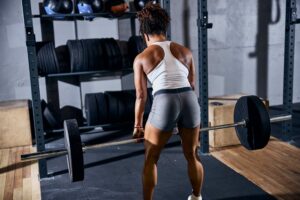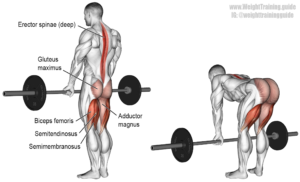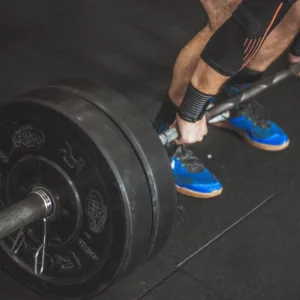The stiff-leg deadlift (SLDL) is a deadlift variation that emphasizes the hamstrings and lower back. It’s an excellent exercise for building strength and size in the posterior chain (the muscles on the back of your body), improving hamstring flexibility and targeting the lower back muscles.
The deadlift has earned its reputation as an effective strength exercise for building muscle. Reaching as far back as the 1700s—and possibly even earlier—deadlift-style movements were circulating in strength competitions and even circus performances. Fast forward to the present day, and it’s a favored staple exercise on the gym floor.
But what exactly are deadlifts, and how can they benefit you in your workout routine? We went to the experts to find out; read on for what they had to say.

 Here’s a closer look at the stiff-leg deadlift:
Here’s a closer look at the stiff-leg deadlift:
1. What it is and how it differs
- Focus on Hamstrings: Unlike the conventional deadlift, the stiff-leg deadlift keeps the knees almost straight throughout the movement, placing a greater stretch and emphasis on the hamstrings and less on the quadriceps.
- Starting Position: Stiff-leg deadlifts can start from the floor or from a rack, similar to Romanian deadlifts (RDLs), depending on hamstring flexibility. Conventional deadlifts begin with the lifter picking up the bar from the floor.
- Lower Back Involvement: The straighter leg position in the SLDL also increases the loading placed upon the lower back muscles (erectors).
- Flexibility: The stiff-leg deadlift requires good hamstring flexibility to perform correctly without rounding the back.
2. Benefits of the stiff-leg deadlift
- Increased Strength and Muscle Growth: Effectively targets the hamstrings, glutes, lower back, and core, leading to increased strength and muscle hypertrophy.
- Improved Hamstring Flexibility: The lengthened position of the hamstrings throughout the lift can help improve flexibility over time.
- Better Posture and Posterior Chain Strength: Strengthens the muscles that contribute to good posture and overall posterior chain development.
- Reduced Risk of Injury: When performed correctly with a neutral spine, it can build lower back resiliency and reduce the risk of injuries.
3. How to perform the stiff-leg deadlift (safe execution)
- Stance: Stand with your feet hip-width or shoulder-width apart, with the barbell positioned over your shoelaces.
- Grip: Grab the barbell with an overhand grip, slightly wider than shoulder-width.
- Initiate the Movement: Push your hips back and hinge forward from the hips, keeping your knees slightly bent but relatively stiff.
- Descent: Lower the barbell in a controlled manner, keeping it close to your body and your back straight. You should feel a stretch in your hamstrings.
- Bottom Position: Lower the barbell as far as your hamstring flexibility allows, ideally to mid-shin or just below the knees.
- Ascent: Drive through your heels, extend your hips, and return to the standing position.
- Breathing: Inhale on the way down, exhale on the way up, according to Myprotein IN.
4. Stiff-leg deadlifts vs. Romanian deadlifts (RDLs)
- Starting Position: RDLs start with the bar in a standing position, while stiff-leg deadlifts start with the bar on the floor or in a rack.
- Knee Bend: RDLs involve a greater bend in the knees, engaging the glutes more, whereas stiff-leg deadlifts keep the knees straighter, emphasizing the hamstrings and lower back.
- Range of Motion: Stiff-leg deadlifts typically have a larger range of motion than RDLs, as the bar touches the floor or a lower rack position.
Check Out Our List Of The Best Supplements For Building Muscle, Shredding Muscle, Recovery, And Great Health, and Wellness Products! Purchase ifbnewsfeed.org‘s apparels Here: ifbnewsfeed.org
-
What Is a Stiff-Leg Deadlift?
“In simple terms, a Stiff-Leg deadlift is a lower-body strength exercise that involves picking up a weight off the ground and moving into a standing position, before lowering the weight down while keeping a neutral spine,” explains certified functional training coach Bory Daniels to IFBNewsfeed.Org.
Perhaps the most crucial element to the deadlift is proper spinal alignment brought about by a hinging motion. “The deadlift is a hinge movement, requiring a bend at the hip joint, and while you may hear of variations, such as the Sumo, Romanian, and single-leg deadlifts, they all require a forward hinge at the waist,” explains Pamela Anderson, a fitness expert, and coach. The upper body and core play a pivotal role in maintaining a neutral spine alignment during both the lifting and lowering phases. “Precision in this hinge movement will effectively recruit the glutes, core, and posterior chain muscles,” Anderson says.
-
What Goals Do Stiff-Leg Deadlifts Achieve?
A Stiff-Leg deadlift falls into the strength-training category, given its purpose is to build strength and muscle.
“As it’s a compound exercise, you’re able to work for multiple muscle groups at once and lift heavier loads, given more muscles are working together,” explains Queen Smith, founder and head trainer of QS Strong. “This makes it an effective strength-building exercise as well as a cardio exercise, as it will elevate your heart rate, not to mention it will help improve posture and stability.”
In terms of functionality, deadlifts replicate movement patterns of everyday life and teach you how to maintain proper form while picking something up from the ground—thereby lowering your risk of injury in day-to-day activities. And, if that wasn’t enough, they also have the potential to bring about exceptional changes to your muscle composition, and therefore the physical body. “Including deadlifts in your workout routine are not only beneficial for performance-related goals, but also in changing the appearance of your physique in accordance with the type of program you are following,” explains Daniels.
On the core front, the muscles running along our back, including the extensors (which support spinal function), help us to physically hold ourselves up to better. “The muscles at the back of our body help us stand up straight and encourage better posture, and they enhance power in everything from running to cycling to climbing,” Anderson adds.
-
When Should You Avoid Them?
As the exercise is both complex and requires precise execution, stiff-leg deadlifts may not be suitable for every person right off the bat. “You’ll want to proceed with caution if you have lower back issues,” warns Fried. “But you don’t necessarily need to avoid deadlifts altogether. If you seek expert guidance from a qualified fitness professional, they can teach you the proper form and modify as required, such as with a sumo deadlift to reduce pressure on the lower back.”
A method to test your readiness to start a deadlift, according to Anderson, is a toe touch. “Those who are unable to perform a proper toe touch and lack the mobility to ‘sit’ back into their hips will need to work on their mobility first,” she says. Jennings suggests working on comfortably holding the bottom segment of the deadlift position, without a lumbar curve in the spine, before proceeding. “It is advised to avoid performing the deadlift when you are unable to get into these positions properly, as it can lead to potential injury, especially when lifting heavier loads,” says Daniels.
But deadlifting isn’t reserved only for those at their physical peak. “You don’t have to be a powerlifter, and you also aren’t required to lift a 45-pound barbell. But, if you suffer from a lower-back issue, you should first consult with your doctor before lifting,” says Anderson. “Anyone new to this movement pattern can begin by lifting lighter weights and mastering the hinge before progressing.”
-
Do You Have to Lift Heavy?
Given the nature of the movement, the stiff-leg deadlift is designed to build strength in the body and therefore requires an element of weight to the exercise. But heavy is relative. “Ideally you should be lifting a weight that is challenging for you while still allowing you to maintain good form, and increasing that weight over time in order to progress and reap physical changes,” shares Daniels.
Simply put, more reps mean less weight, to ensure there is no compromise to form. “You do not have to necessarily lift ‘heavy’ for stiff-leg deadlifts to be effective,” says Anderson. In fact, the general consensus on repetition ranges is from 1–5 reps for building strength, 6–12 reps for hypertrophy (muscle growth), and 15 reps or more for endurance and ‘toning’ of the muscles. “Ideally, in order to progress, as long as proper form is being maintained, increasing the weight that you’re lifting for your deadlift each week is going to be helpful to gain strength and reach your goals more quickly,” says Pamela.
-
Are Stiff-leg Deadlifts for You?
If you want to improve your strength, increase muscle mass, and work on your posterior chain, deadlifts should make an appearance on your workout schedule.
“The stiff-leg deadlift is a movement pattern everyone should learn, just like the squat,” states Anderson. “And just like the squat, you can modify the movement to be unloaded, but when a load is added, it becomes a very effective exercise for a full-body workout!”
Wrapping Up
Related Articles:

- Hormone Replacement Therapy regimen For Men and women
- Hormone Blood Testing for Men (Bodybuilder Blood Testing)
- Shop Optimum Nutrition Energy: Anytime & Pre-Workout
For More News And Daily Updates, Follow IFBNewsfeed.Org on Facebook, Twitter, and Instagram. Comment, Like, And Share With Everyone Who May Need To Be Updated With The Most Recent Fitness/Bodybuilding/Powerlifting And CrossFit News.









